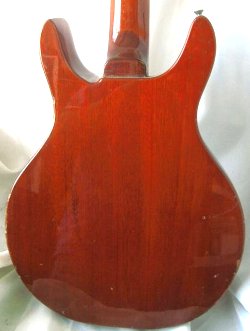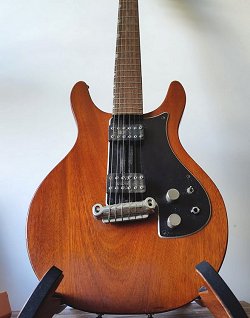

|
Unlike the Dan Armstrong Ampeg acrylic guitars & basses, these instruments featured set-in type necks. The necks
themselves were made of the same beautiful Honduras mahogany as the body and features a rosewood fingerboard and an
adjustable truss rod.
From the backside one can clearly see the resemblence between these guitar bodies and the clear acrylic models that
Dan made with Ampeg some years earlier. Notice the cutaway on the lower horn and you will see that the body is shaved
down a bit in order for a player to get to the upper registers of the fingerboard.
|
As seen above, the headstock looks very much like a Gibson style headstock but it eventually takes on an
interesting 'Gumby' type sweep towards the top. As can be seen at left, the front of the headstock has an anodized
aluminum veneer, or cover. According to literature, being this was made of aluminum, it resists burns due to a
smoldering cigarette that players sometimes leave burning underneath a string. Photos are courtesy of Paul Q. Kolderie.
The aluminum is etched with Dan's name across the top and often (though not always - as in this case) the word 'London'
is etched in underneath Dan's name. Also seen on the headstock is a unique truss rod cover. Rather than just using a
plastic cover, Dan decided to use a stamped aluminum cover that is somewhat teardrop & bubble shaped, and due to its
design, it automatically seats itself utilizing only one set screw.
Lastly, towards the bottom of the photo the zero fret & aluminum nut can be seen. When asked about it Dan replied
"The zero nut aids in helping the intonation and tuning a bit, especially when using an aluminum nut like these
guitars do. Also, when cutting the string slots in the nut one can more easily see how deep they are going - being you
have a fret close by - and that helps to keep you from cutting the slot too shallow, or worse, too deep."
Notice the aluminum nut, and in particular notice the highly polished and buffed out shine it has. This is necessary
throughout in order to keep the strings, especially any of the wound strings from catching or grabbing on the nut
itself. "It was yet another added step, &/or expense" replied Tony Pitt.
At upper right, seen from the rear of the headstock - these guitars were equipped with Schaller tuners just like
the early (and very late) models of Dan Armstrong/Ampeg clear acrylic instruments used. Dan still insisted on using
the highest quality components that were available for his instruments.
As seen upper left, a more common Dan Armstrong 'London' headstock with the word London etched in underneath
Dan's name. At upper right, a closer inspection of the aluminum nut and zero fret can be seen. Photos are courtesy of Logan Beveridge.
At left, and underneath the truss rod cover lies a single steel adjustable truss rod to help keep the mahogany neck straight and
true for the best possible string action. According to Kent Armstrong a metric sized allen wrench is
required to make adjustments to the truss rod. Photos are courtesy of Logan Beveridge.
Also located in this area is the instruments serial number. This guitar has the serial number 4324.
According to both Kent Armstrong & Dan's good friend
Craig Buzzart - who was the North American west coast distributor of these instruments - "The first digit is
the year of manufacture, the second is the quarter of that year, while the third digit(s) represent the actual
number that was built in that quarter." In this particular case, this guitar appears to have been built in 1974,
in the 3rd quarter of that year, and is the 24th one that was built in that particular quarter. Kent would also stamp
this number into the routed control cavity of the instrument. Notice the thickness of the aluminum veneer cap on the
mahogany headstock.
At upper right, and according to Tony Pitt "While the guitars might look somewhat plain due to the straight grain of the mahogany wood -
they were anything but. In fact, they were expensive to produce - for example, the aluminum head cover had to be cut
and finished 'spot on' as you couldn't just sand it until it was flush like most other guitars. When cutting the
aluminum our tools were often littered with burr's and needle size pieces of aluminum all which greatly dulled the
cutting tools. More time and money was involved but everything about it appealed to Dan, if not to our accountants."
At upper left, these instruments employed 'thumb print' style position markers that were made of aluminum for
longer wear & maximum visibility. At upper right, another view of the position markers set against the rosewood
fingerboard. According to Craig Buzzart, "When you look at the thumbnail position markers, the zero fret, and
headstock shape, it's obvious that Dan designed the London type instruments using many Gretsch style appointments."
Photos are courtesy of Logan Beveridge.
At upper left, the beautiful grain and smooth resin finish of the neck. At upper right, the neck as seen when
planing down it.

|
At left, a beautiful Dan Armstrong London guitar. Unlike most guitar models this one is sporting two pickups which is extremely rare for
this model. Being a two pickup model a pickup selector switch was added to the pickguard.
|
Although these instruments feature double cutaways and - like the Dan Armstrong acrylic guitars
before them - have some extra mass trimmed away in the lower cutaway so that players could access the upper frets on the
treble side, players still complained that they simply could not get their hand around the neck good enough to play
in those upper registers. Apparently enough complaints came in that it forced a change to the body style, and that meant
additional costs were to be incurred on what were already expensive instruments to build.
"We incurred even more expense by changing over to a new body style" said Tony Pitt, who went on to add
"we had to go back to square one and start all over with a design that would be functional, yet allow the players
to reach the upper frets. Dan was brilliant with new ideas and came up with a new design fairly quickly, but then we
had to have all new templates made, not only for the body, but even for the scratchplates as they took on a different
shape as well."
continue
menu
Names and images are TMand © Dan Armstrong / Ampeg. All rights reserved.
All other names and images are TMand © of their respective owners. All rights reserved.
|
| |

